A Modular 512-Channel Neural Signal Acquisition ASIC for High-Density 4096 Channel Electrophysiology †
Abstract
:1. Introduction
2. Materials and Methods
2.1. System Overview
2.2. Circuit Design
2.2.1. Analog Front-End
2.2.2. Sigma–Delta ADC Specification
2.2.3. Sigma-Delta Modulator
2.2.4. Digital Decimation Filter
2.2.5. Digital Services
2.3. Chip Layout and Fabrication
3. Results and Discussion
3.1. Standalone Measurements
3.1.1. Chip Performance
3.1.2. Data Post-Processing
3.1.3. Electroplating and Electrode Impedance Measurements
3.2. In Vivo Electrophysiology
4. Conclusions
Author Contributions
Funding
Institutional Review Board Statement
Informed Consent Statement
Data Availability Statement
Acknowledgments
Conflicts of Interest
References
- Litvina, E.; Adams, A.; Barth, A.; Bruchez, M.; Carson, J.; Chung, J.E.; Dupre, K.B.; Frank, L.M.; Gates, K.M.; Harris, K.M.; et al. BRAIN Initiative: Cutting-Edge Tools and Resources for the Community. J. Neurosci. 2019, 39, 8275–8284. [Google Scholar] [CrossRef] [PubMed]
- Buzsáki, G.; Stark, E.; Berenyi, A.; Khodagholy, D.; Kipke, D.R.; Yoon, E.; Wise, K.D. Tools for probing local circuits: High-density silicon probes combined with optogenetics. Neuron 2015, 86, 92–105. [Google Scholar] [CrossRef]
- Chung, J.E.; Joo, H.R.; Fan, J.L.; Liu, D.F.; Barnett, A.H.; Chen, S.; Geaghan-Breiner, C.; Karlsson, M.P.; Karlsson, M.; Lee, K.Y.; et al. High-Density, Long-Lasting, and Multi-region Electrophysiological Recordings Using Polymer Electrode Arrays. Neuron 2019, 101, 21–31.e5. [Google Scholar] [CrossRef] [PubMed]
- Du, J.; Blanche, T.J.; Harrison, R.R.; Lester, H.A.; Masmanidis, S.C. Multiplexed, High Density Electrophysiology with Nanofabricated Neural Probes. PLoS ONE 2011, 6, e26204. [Google Scholar] [CrossRef] [PubMed]
- Intan Technologies. RHD Electrophysiology Amplifier Chips. Available online: https://intantech.com/products_RHD2000.html (accessed on 10 October 2022).
- Lopez, C.M.; Mitra, S.; Putzeys, J.; Raducanu, B.; Ballini, M.; Andrei, A.; Severi, S.; Welkenhuysen, M.; Van Hoof, C.; Musa, S.; et al. A 966-electrode neural probe with 384 configurable channels in 0.13 µm SOI CMOS. In Proceedings of the 2016 IEEE International Solid-State Circuits Conference (ISSCC), San Francisco, CA, USA, 31 January–4 February 2016; pp. 392–393. [Google Scholar] [CrossRef]
- Steinmetz, N.A.; Aydin, C.; Lebedeva, A.; Okun, M.; Pachitariu, M.; Bauza, M.; Beau, M.; Bhagat, J.; Böhm, C.; Broux, M.; et al. Neuropixels 2.0: A miniaturized high-density probe for stable, long-term brain recordings. Science 2021, 372, eabf4588. [Google Scholar] [CrossRef] [PubMed]
- Sahasrabuddhe, K.; A Khan, A.; Singh, A.P.; Stern, T.M.; Ng, Y.; Tadić, A.; Orel, P.; LaReau, C.; Pouzzner, D.; Nishimura, K.; et al. The Argo: A high channel count recording system for neural recording in vivo. J. Neural Eng. 2020, 18, 015002. [Google Scholar] [CrossRef] [PubMed]
- Papadopoulou, A.; Hermiz, J.; Grace, C.; Denes, P. A 512-Channel Neural Signal Acquisition ASIC for High-Density Electrophysiology. In Proceedings of the 2022 IEEE International Symposium on Circuits and Systems (ISCAS), Austin, TX, USA, 27 May–1 June 2022; pp. 938–942. [Google Scholar] [CrossRef]
- Chung, J.E.; Magland, J.F.; Barnett, A.H.; Tolosa, V.M.; Tooker, A.C.; Lee, K.Y.; Shah, K.G.; Felix, S.H.; Frank, L.M.; Greengard, L.F. A Fully Automated Approach to Spike Sorting. Neuron 2017, 101, 1381–1394. [Google Scholar] [CrossRef] [PubMed]
- Hermiz, J.; Joseph, E.; Lee, K.H.; Baldacci, I.A.; Chung, J.E.; Frank, L.M.; Bouchard, K.; Denes, P. The impact of reducing signal acquisition specifications on neuronal spike sorting. In Proceedings of the 2021 43rd Annual International Conference of the IEEE Engineering in Medicine & Biology Society (EMBC), Virtual, 1–5 November 2021. [Google Scholar]
- Kassiri, H.; Salam, M.T.; Pazhouhandeh, M.R.; Soltani, N.; Velazquez, J.L.P.; Carlen, P.; Genov, R. Rail-to-Rail-Input Dual-Radio 64-Channel Closed-Loop Neurostimulator. IEEE J. Solid-State Circuits 2017, 52, 2793–2810. [Google Scholar] [CrossRef]
- Yang, X.; Ballini, M.; Sawigun, C.; Hsu, W.-Y.; Weijers, J.-W.; Putzeys, J.; Lopez, C.M. A 128-Channel AC-Coupled 1st-order Δ-ΣΔ IC for Neural Signal Acquisition. In Proceedings of the 2022 IEEE Symposium on VLSI Technology and Circuits (VLSI Technology and Circuits), Honolulu, HI, USA, 12–17 June 2022; pp. 60–61. [Google Scholar] [CrossRef]
- Yang, Y.; Chokhawala, A.; Alexander, M.; Melanson, J.; Hester, D. A 114-dB 68-mW Chopper-stabilized stereo multibit audio ADC in 5.62 mm2. IEEE J. Solid-State Circuits 2003, 38, 2061–2068. [Google Scholar] [CrossRef]
- Pavan, S.; Schreier, R.; Temes, G. Understanding Delta-Sigma Data Converters, 2nd ed.; Wiley-IEEE Press: New York, NY, USA, 2017. [Google Scholar] [CrossRef]
- Hogenauer, E. An economical class of digital filters for decimation and interpolation. IEEE Trans. Acoust. Speech Signal Process. 1981, 29, 155–162. [Google Scholar] [CrossRef]
- Weste, N.; Harris, D. CMOS VLSI Design: A Circuits and Systems Perspective, 4th ed.; Addison-Wesley: Boston, MA, USA, 2011. [Google Scholar]
- Han, J.; Choi, J.; Jeong, H.; Park, D.; Cheong, E.; Sung, J.; Choi, H.-J. Impact of Impedance Levels on Recording Quality in Flexible Neural Probes. Sensors 2024, 24, 2300. [Google Scholar] [CrossRef] [PubMed]
- Schörkhuber, C.; Klapuri, A. Constant-Q transform toolbox for music processing. In Proceedings of the 7th Sound and Music Computing Conference, Barcelona, Spain, 21–24 July 2010. [Google Scholar]
- Buccino, A.P.; Hurwitz, C.L.; Garcia, S.; Magland, J.; Siegle, J.H.; Hurwitz, R.; Hennig, M.H. SpikeInterface, a unified framework for spike sorting. eLife 2020, 9, e61834. [Google Scholar] [CrossRef] [PubMed]
- Kim, S.-J.; Han, S.-H.; Cha, J.-H.; Liu, L.; Yao, L.; Gao, Y.; Je, M. A Sub-μW/Ch Analog Front-End for Δ-Neural Recording With Spike-Driven Data Compression. IEEE Trans. Biomed. Circuits Syst. 2019, 13, 1–14. [Google Scholar] [CrossRef] [PubMed]
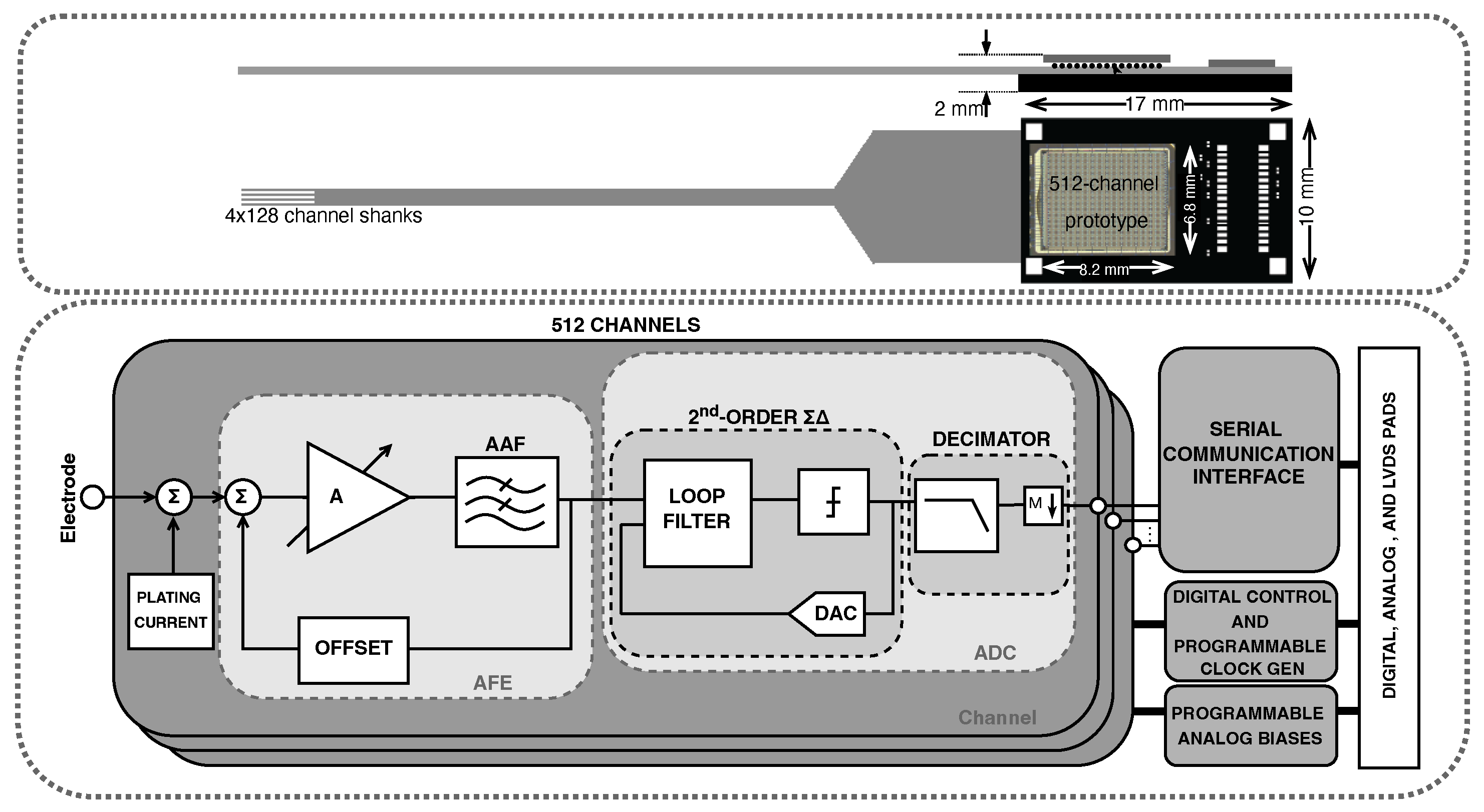

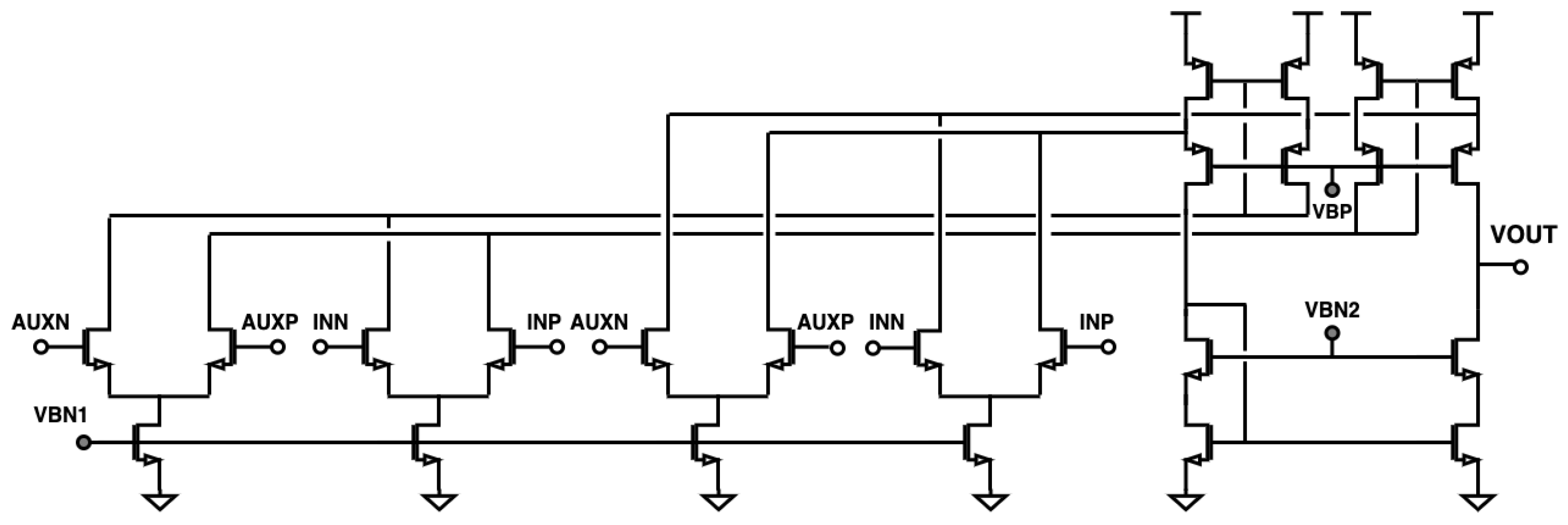


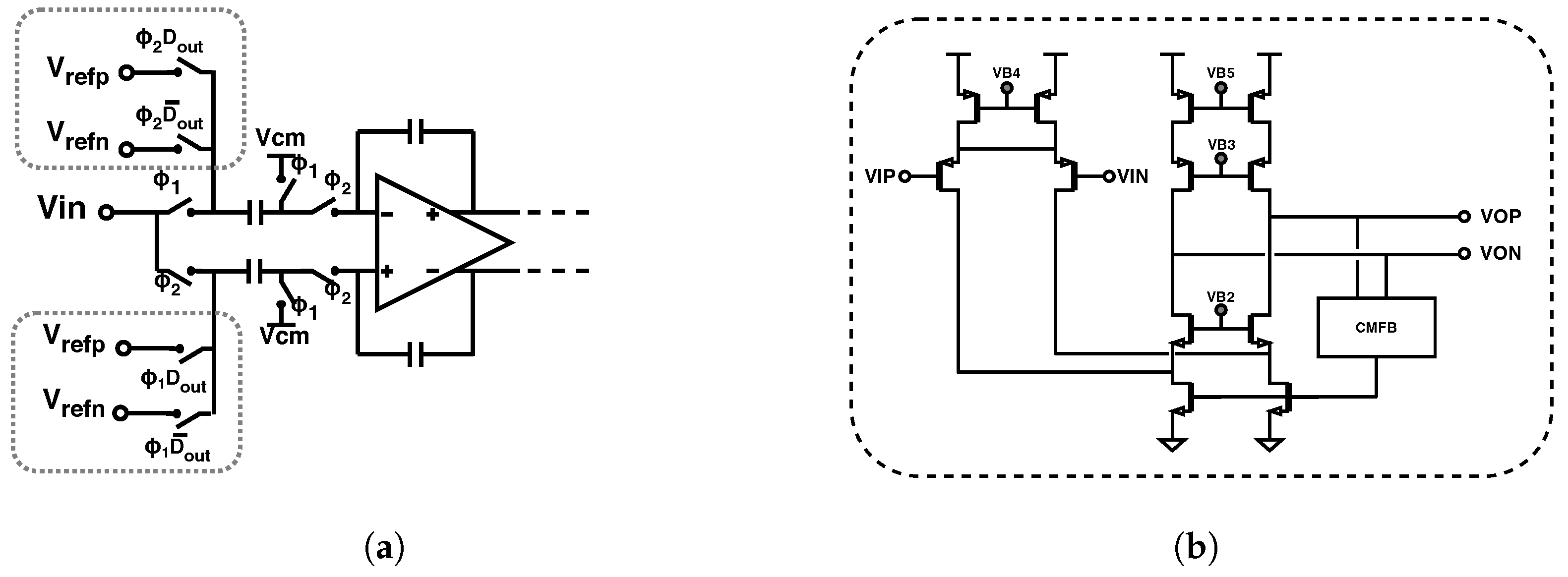










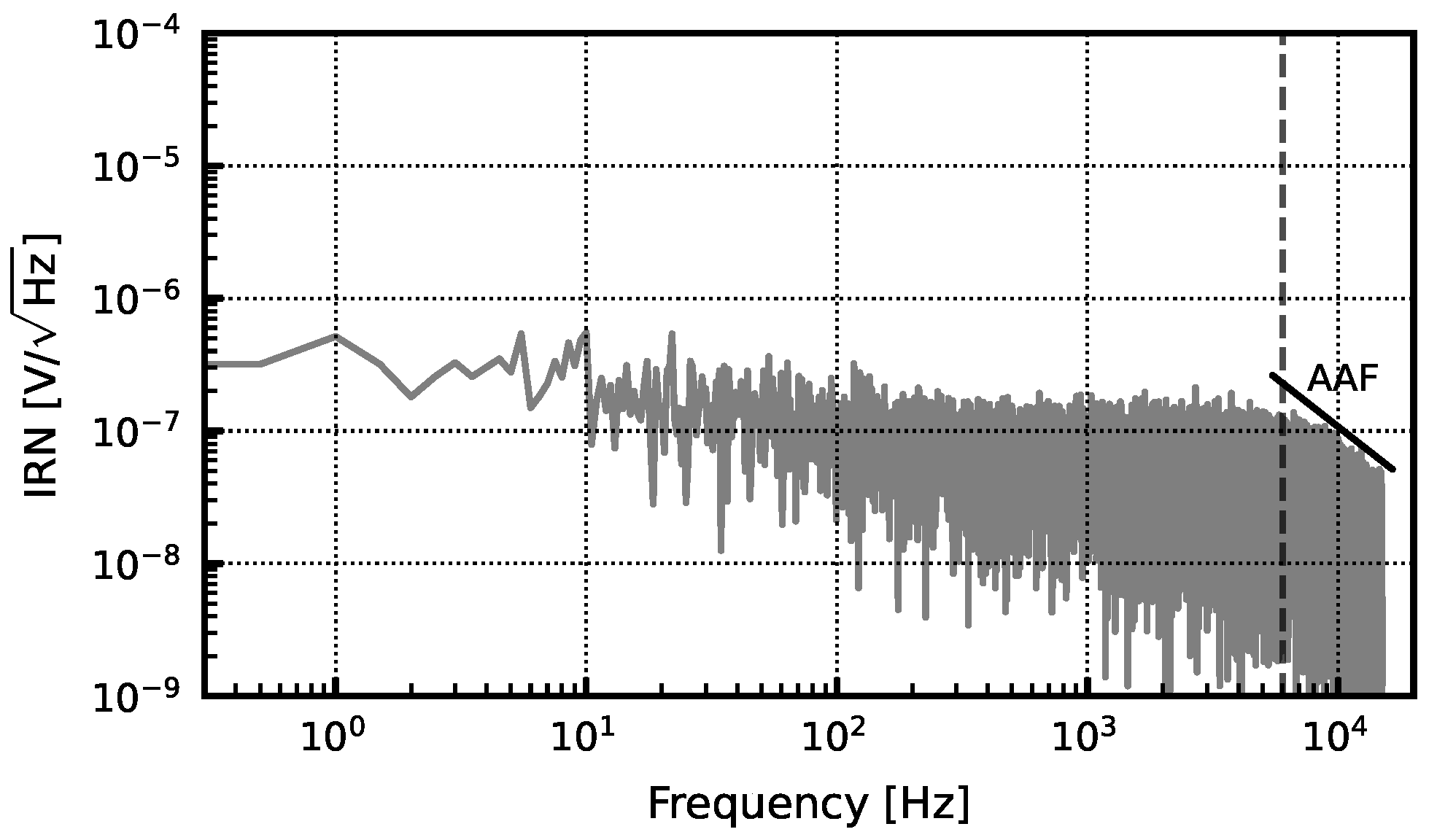
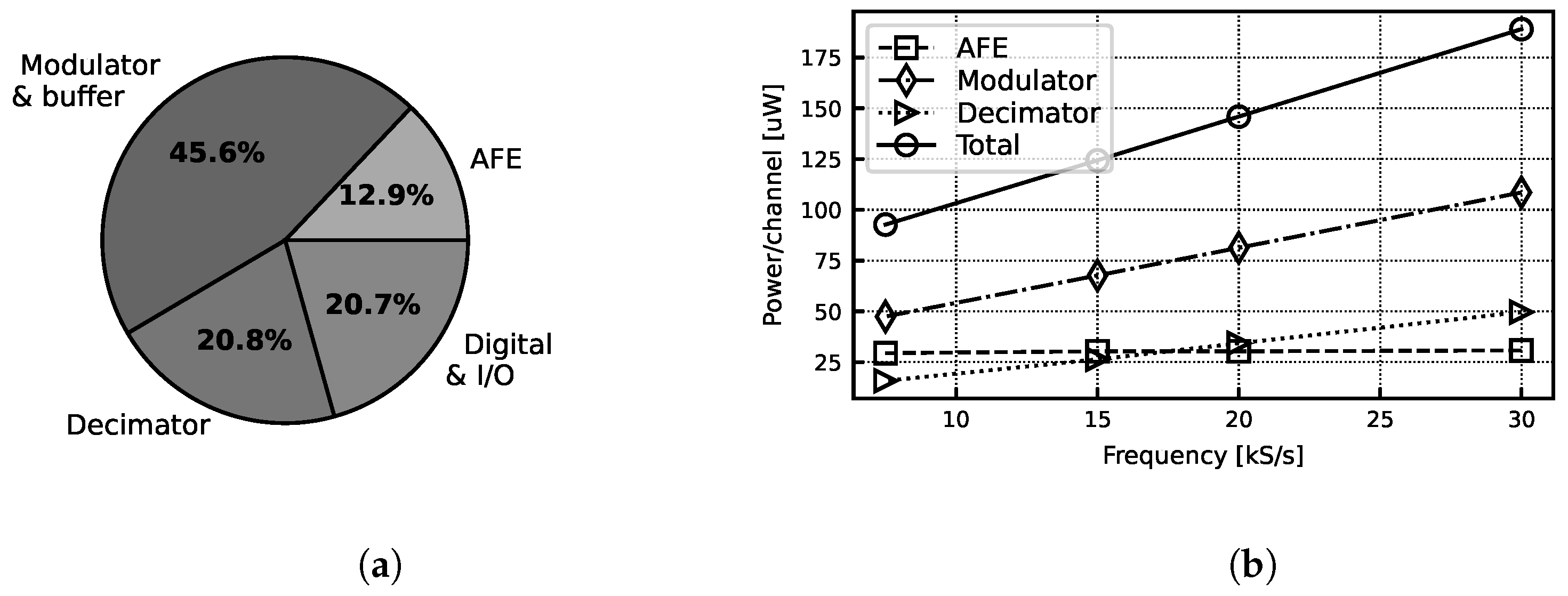
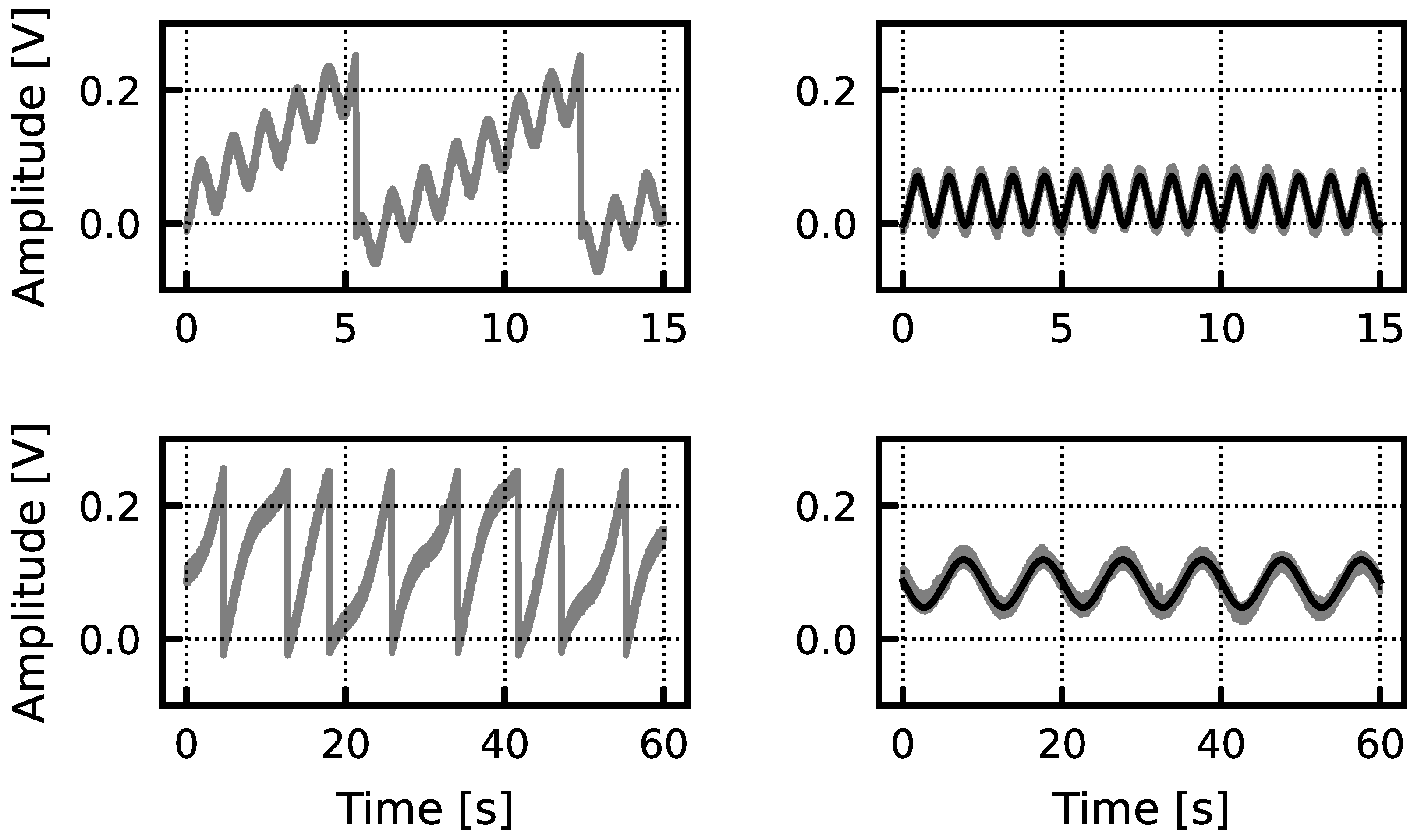
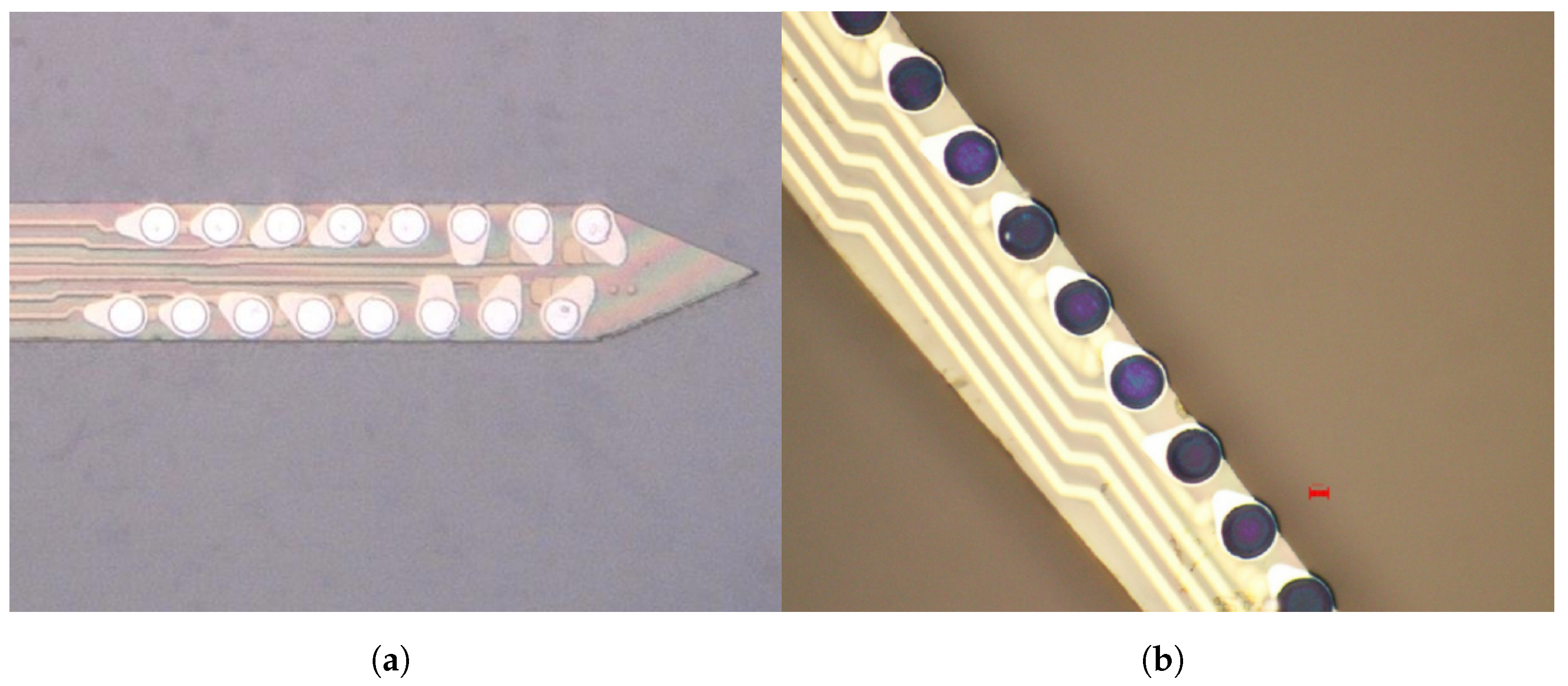
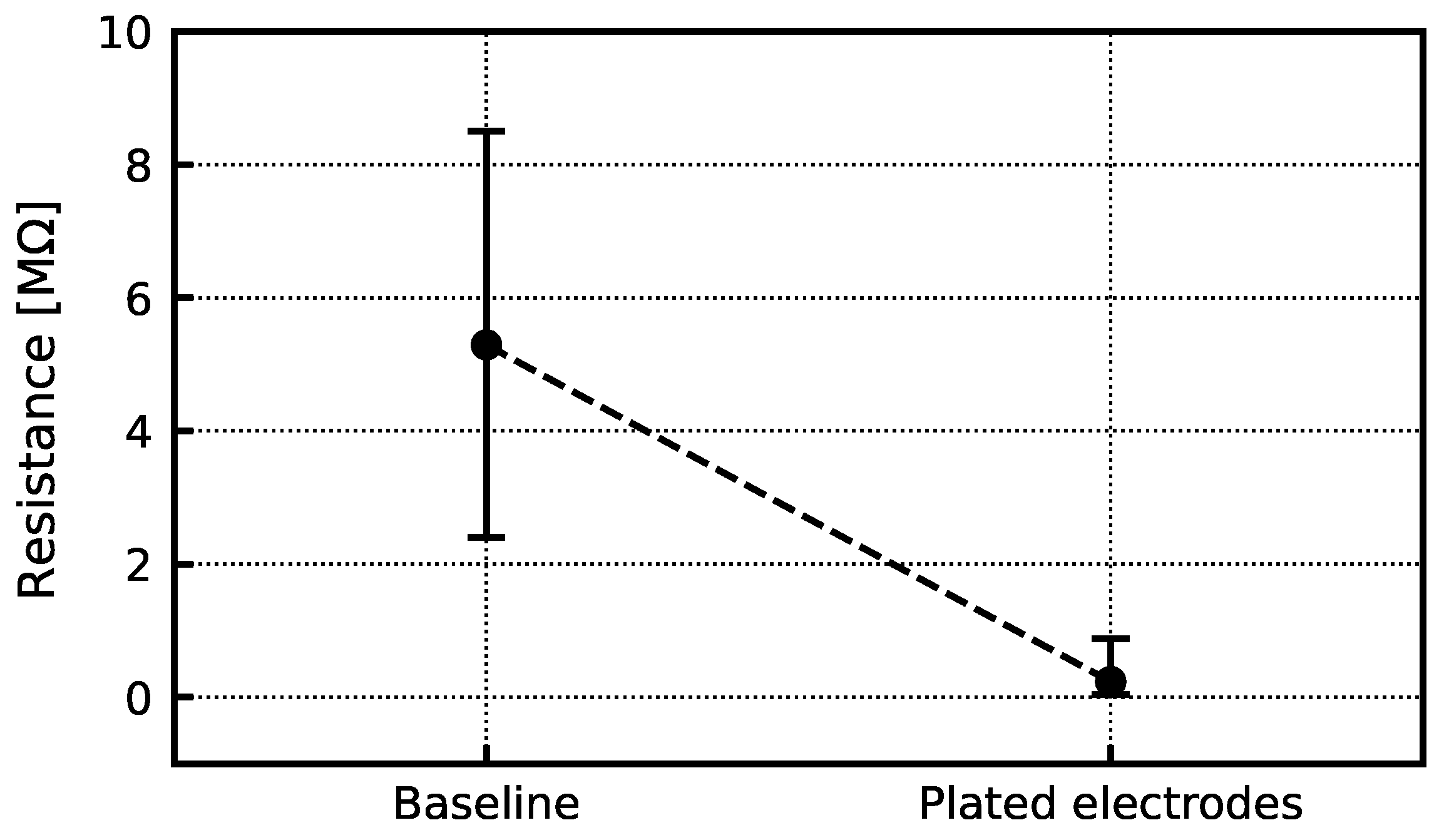



| Circuit | Instances | Transistors | Total Transistors |
|---|---|---|---|
| Coder | 1 | 42 | 42 |
| Integrator | 3 | 880 | 2640 |
| Downsampler | 1 | 132 | 132 |
| Differentiator | 3 | 1012 | 3036 |
| Complete Filter | 1 | 5850 | 5850 |
| [5] | [6] | [13] | [21] | This Work | |
|---|---|---|---|---|---|
| Channels | 64 | 384 | 128 | 16 | 512 |
| Tot. area [mm2] | 28.7 | 45.2 | 0.005 | 5.8 | 55.8 |
| Area/ch. [mm2] | 0.448 a | 0.12 | 0.0045 | 0.16 | 0.099 |
| ADC bits | 16 | 10 | 14 | 8 | 14 |
| ADC [kHz] | 30 | 30 | 30 | 31.25 | 30 |
| IRN (LFP) [V] | 2.4 b | 10.32 | 11.9 | - | 3.1 |
| IRN (AP) [µV] | 2.4 b | 6.36 | 7.71 | 5.4 c | 5.4 |
| Power/ch. [µW] | 351 | 49.06 | 8.34 | 0.96 | 244 |
| Supply [V] | 3.0 | 1.2/1.8 | 0.8 | 0.5 | 1.8 |
| In vivo results | Yes | Yes | No | Yes | Yes |
| Technology [µm] | 0.35 | 0.13 SOI | 0.022 | 0.18 | 0.18 |
Disclaimer/Publisher’s Note: The statements, opinions and data contained in all publications are solely those of the individual author(s) and contributor(s) and not of MDPI and/or the editor(s). MDPI and/or the editor(s) disclaim responsibility for any injury to people or property resulting from any ideas, methods, instructions or products referred to in the content. |
© 2024 by the authors. Licensee MDPI, Basel, Switzerland. This article is an open access article distributed under the terms and conditions of the Creative Commons Attribution (CC BY) license (https://creativecommons.org/licenses/by/4.0/).
Share and Cite
Papadopoulou, A.; Hermiz, J.; Grace, C.; Denes, P. A Modular 512-Channel Neural Signal Acquisition ASIC for High-Density 4096 Channel Electrophysiology. Sensors 2024, 24, 3986. https://doi.org/10.3390/s24123986
Papadopoulou A, Hermiz J, Grace C, Denes P. A Modular 512-Channel Neural Signal Acquisition ASIC for High-Density 4096 Channel Electrophysiology. Sensors. 2024; 24(12):3986. https://doi.org/10.3390/s24123986
Chicago/Turabian StylePapadopoulou, Aikaterini, John Hermiz, Carl Grace, and Peter Denes. 2024. "A Modular 512-Channel Neural Signal Acquisition ASIC for High-Density 4096 Channel Electrophysiology" Sensors 24, no. 12: 3986. https://doi.org/10.3390/s24123986






